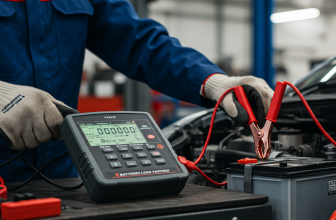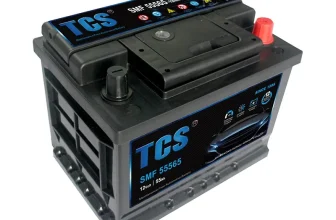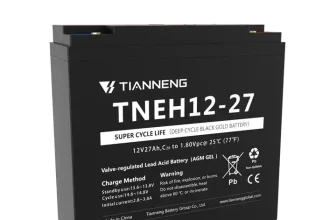Car batteries, also known as automotive batteries, serve as a crucial
component in vehicles. Situated under the hood, this electrochemical
device plays an imperative role, much like the heart in a living
organism. It provides the much-needed electrical energy to start the
engine and for the functioning of other electrical parts. It does so by
storing and releasing energy through a chemical reaction between the
acid and the lead inside it.
The absence of a battery, or the failure of one, can lead to numerous
problems – from an inability to start the car, to the failure of
important systems like lights, music system, air-conditioning,
navigation, and safety airbags among others. It’s responsible for
powering not just the vehicle’s starter motor and ignition system, but
also all the electronic devices and accessories within the car when the
vehicle’s engine is off. Thus, without an operational battery, your
vehicle would be rendered virtually useless.
Definition of Cold
Cranking Amps (CCA)
Detailed
explanation of what Cold Cranking Amps are
Cold Cranking Amps, commonly referred to as CCA, is a crucial metric
found in the specifications of a car battery. It indicates the number of
amps that a 12-volt battery can deliver for 30 seconds at zero degrees
Fahrenheit without dropping below 7.2 volts. Simply put, CCA measures
the battery’s ability to start an engine in cold temperature.
The term ‘Cold Cranking’ finds its roots in the hardship of starting
a cold engine, as more energy is required when the engine oil is thick,
and engine parts are not as malleable. ‘Amps’ is short for amperes,
which is a unit measuring electrical current, hence the term Cold
Cranking Amps represents the battery’s ability to turn over the engine
and start the car in cold conditions.
As a quantifiable value, CCA becomes an essential piece of
information for those living in cold climates. It signifies the initial
starting power of the battery, directly influencing the car’s ability to
start in freezing temperatures.
Why it’s important to
understand CCA
Understanding the concept of Cold Cranking Amps (CCA) is crucial for
multiple reasons, particularly for those living in colder environments.
CCA is the measure of a battery’s capacity to start an engine under cold
temperature conditions. It basically represents the number of amps a
12-volt battery can deliver at 0°F for 30 seconds while maintaining a
voltage of at least 7.2 volts. Therefore, the higher the CCA, the better
the performance of the battery in cold weather.
Primarily, CCA is a crucial factor in determining the ability of the
battery to start an engine during cold weather. Automobile engines
require a significant amount of energy to start, and this requirement
increases during low temperatures. A battery with a high CCA can deliver
more power, thereby enabling the engine to start more reliably in cold
conditions.
Moreover, understanding CCA values is key to selecting the correct
battery for your vehicle. Car manufacturers often provide a recommended
minimum CCA rating for their vehicles. Therefore, knowing CCA helps you
make an informed decision when replacing or upgrading your car battery,
to ensure it meets the necessary specifications for your vehicle.
In summary, understanding the importance of CCA is fundamental in
ensuring smooth vehicle operation, particularly in colder climates, and
making informed decisions when purchasing a car battery.
How Cold Cranking Amps Work
Process of how CCA
affects car batteries
Cold Cranking Amps (CCAs) play a pivotal role in the functioning of a
car battery, particularly when starting your vehicle in cold weather
conditions. The term ‘Cold Cranking’ refers to the ability of the
battery to start an engine under cold temperatures, and ‘Amp’ is a unit
of electric current.
To understand how CCAs influence car batteries, think of the starter
motor of a car which demands a substantial surge of electrical energy to
bring your car to life. This surge is measured in CCAs, and it
illuminates the importance of this specification. It’s the number of
amps that a 12-volt battery can deliver at 0°F for 30 seconds, while
maintaining at least 7.2 volts. This is significant because the lower
the temperature, the more power it takes to start the engine.
Furthermore, the engine oil becomes thicker in cold temperatures,
making it harder for the engine components to move. This leads to a
higher demand for electrical power to overcome the resistance and start
the vehicle – a task essentially handled by the battery’s CCAs. The
higher the CCA, the greater the battery’s ability to start a vehicle in
cold temperatures. That’s why, in colder climates, choosing a car
battery with higher CCAs becomes crucial to ensure a smooth and reliable
vehicle operation.
In summary, CCAs dictate your vehicle’s ability to cope with the cold
and power through those chilly winter mornings. They provide the
essential initial energy needed to start the engine, thereby playing a
crucial role in the overall performance of your car’s battery.
Impact of temperature on CCA
Temperature plays a significant role in the effectiveness of the Cold
Cranking Amps (CCA) of a battery. The term “cold cranking” itself refers
to the ability of the battery to start an engine in cold temperatures.
The colder the climate, the more power is required to start the engine,
increasing the importance of a battery’s CCA rating.
As the temperature drops, the chemical reactions within a battery
also slow down. This reduction in activity results in less energy being
readily available, making it harder for the battery to start the engine.
For instance, at 32 degrees Fahrenheit (0 degrees Celsius), a battery
only has around two-thirds of its rated capacity. As the temperature
falls further, the capacity drops accordingly.
This is why battery specifications often include a CCA rating, which
represents the number of amps a battery can deliver at 0 degrees
Fahrenheit for 30 seconds while maintaining at least 7.2 volts. A higher
CCA rating means that a battery will be better able to start an engine
in colder weather.
So, whether you live in a region with freezing winters or
occasionally encounter cold mornings, considering the CCA rating of a
car battery becomes critical. This rating enables you to assess and
ensure that your vehicle will start reliably, whatever the weather may
throw at it.
Importance of High CCA
in Car Batteries
Benefits of having a high
CCA
A car battery with a high Cold Cranking Amps (CCA) rating has several
benefits which contribute to enhanced vehicle performance. First and
foremost, it enables a strong and reliable start of the vehicle’s
engine, especially in colder climates where motor oil thickens and
engine parts don’t move as freely. This strong kick-start power is
crucial on chilly mornings to ensure your car springs to life with
minimal effort.
Secondly, a high CCA rating also means that the battery can support
more electrical demands. Cars today come with advanced features like
power windows, automatic headlights, heated seats, among others, which
all call for considerable energy. A high CCA battery is equipped to
sufficiently meet these demands without draining quickly or struggling
to provide necessary power.
Lastly, batteries with a high CCA rating exhibit longer life spans.
They are built to withstand the demands of high cranking situations and
repeated cycling between charging and discharging as they are designed
to perform under tough conditions. This ultimately results in cost
savings as it reduces the frequency of battery replacements.
In short, a high CCA car battery ensures a reliable start, meets high
energy demands, and promises longevity—three major advantages that
contribute to smooth driving experiences.
Drawbacks of low CCA
and potential dangers
Low CCA can present numerous drawbacks, with potential dangers that
are certainly worth considering. One major problem with a low CCA is
that it may not provide enough power to start your vehicle reliably,
especially in colder temperatures. When you crank your car, you’re
asking the battery to do a significant amount of work in a short time,
and a low CCA rating means that the battery isn’t capable of supplying
this high burst of power needed.
Moreover, a battery with a low CCA is likely to deteriorate faster
than one with a higher rating. This is because the battery will need to
work harder each time you try to start the vehicle, straining its
components and reducing its service life. In turn, this might mean
replacing your battery more frequently, resulting in a higher total cost
of ownership.
It’s also worth mentioning the potential dangers of a low CCA. If
your battery doesn’t have the power to start your car in a demanding
situation, it might leave you stranded in a dangerous or inconvenient
location, or in extreme cold weather. A vehicle failing to start due to
low battery power could also interrupt vital functions such as heating
and air conditioning systems, further posing risks to the vehicle’s
occupants.
Overall, the drawbacks of a low CCA should not be taken lightly, due
to the potential implications for both vehicle performance and personal
safety.
Selecting a Car
Battery – The Role of CCA
How to assess CCA
when choosing a car battery
Choosing a suitable car battery that aptly fits your vehicle’s
requirements entails a good understanding of the Cold Cranking Amps. CCA
is a crucial factor to assess when purchasing a new battery, primarily
if you live in colder climates or your car has hefty power
requirements.
To evaluate the CCA, first, look into your car’s manual or consult a
professional to know your vehicle’s necessary CCA requirement. Car
manufacturers often provide these specifications. Usually, larger
engines and diesel vehicles will need a higher CCA rating to crank over
in the cold.
When browsing for a car battery, make sure to check its packaging or
specification label. This information will have the CCA rating
indicated, typically within a range from about 400 to over 1000. The CCA
rating is standardized, and so it is easily comparable across different
makes and models of car batteries.
As a rule of thumb, seek a battery with higher CCA ratings,
especially if you regularly experience frigid temperatures where your
car is typically used. However, bear in mind not to exceed the
manufacturer’s requirements by a wide margin, as too high CCA may lead
to other complications.
In essence, understanding CCA comes down to knowing your vehicle’s
needs and matching them to a battery that can meet those needs. Both too
low and excessively high CCA can cause issues, so achieving the right
balance is the key to a successful car battery purchase.
Factors
to consider along with CCA during battery purchase
When you are in the market for a new car battery, the Cold Cranking
Amps (CCA) rating should without a doubt be one of your key
considerations. However, it shouldn’t be the sole deciding factor. Here
are other crucial factors you should consider alongside CCA.
- Reserve Capacity: This indicates how long your battery can
provide power if the alternator fails. A higher reserve capacity is
better, as it means your battery can handle more demand. - Battery Size: A battery that doesn’t fit properly in your car’s
battery tray can cause operational problems. Always refer to your
vehicle’s manual to find the correct battery size. - Battery Age: Check the manufacture date on the label. A battery
shouldn’t be on the shelf for more than six months. - Maintenance Needs: Some batteries need regular topping up with
distilled water, while others are ‘maintenance-free.’ Your lifestyle and
preference will determine your choice. - Warranty: Look for a battery with a long full-replacement
warranty. This is a superior option compared to pro-rata warranties,
which reduce the value with the battery age. - Power Requirement: Your battery should meet your vehicle’s power
requirement. If you have a car with multiple power-draining accessories,
go for a battery with higher power. - Brand Reputation: It is often safer to buy from well-known brands
due to their experience and trust built over time.
By keeping these factors in mind along with the CCA, you’ll be much
better equipped to find the perfect battery that adequately meets your
vehicle’s needs. Remember, the health of your car starts with a reliable
battery, so making an informed decision is paramount.
Conclusion
Recap
of importance and role of Cold Cranking Amps in car battery
We have examined the crucial role and significance of Cold Cranking
Amps (CCA) in a car battery. This is a crucial rating that tells you how
capable your car battery is at starting your engine in cold weather
conditions. It reflects the number of amperes a battery can support for
30 seconds at a temperature of 0 degrees Fahrenheit until the battery
voltage drops to unusable levels.
A high CCA rating signifies a more potent capability to start your
engine in cold conditions. A low CCA, however, could leave you stranded
in cold weather with a vehicle that refuses to start. As well as
understanding the purpose of CCA ratings, it’s also important to
consider them when choosing a battery for your automobile. Balancing CCA
with other factors like battery size, reserve capacity, and your
vehicle’s power requirements will help you select a battery that’s just
right for you.
In conclusion, taking CCA into consideration when selecting a car
battery ensures its efficacy and longevity, thus saving you money and
preventing inconvenient break downs. It’s one more tool in your arsenal
to ensure the smooth running and reliability of your vehicle.
Encouragement
to consider CCA when making a car battery purchase.
By understanding and acknowledging the role of Cold Cranking Amps
(CCA) in a car battery, one can make an informed decision when
purchasing their next battery. Choosing a battery with the correct CCA
for your vehicle can simplify your driving experience, especially in
cold weather conditions. The negative impact of a wrong purchase, on the
other hand, may lead to vehicle failure at the most inconvenient times.
Therefore, never overlook the importance of CCA; let it guide you
towards a purchase that will ensure your vehicle remains efficient,
reliable, and stands up to the tests of time and weather. Consider CCA
as a significant benchmark while making your next car battery
acquisition for a smoothly functioning and longer lasting vehicle.







